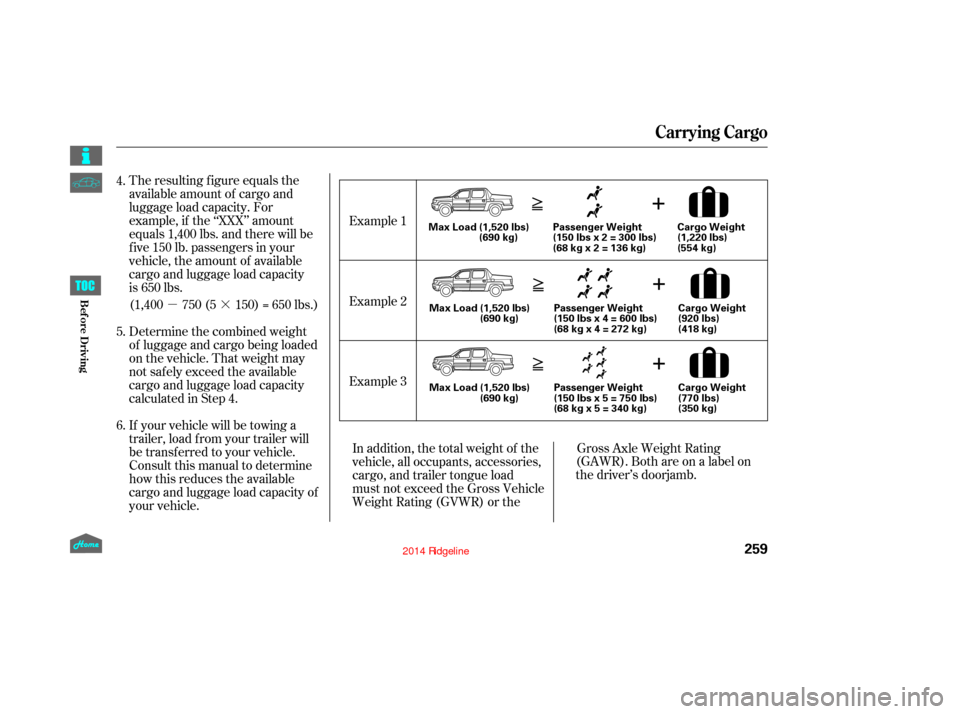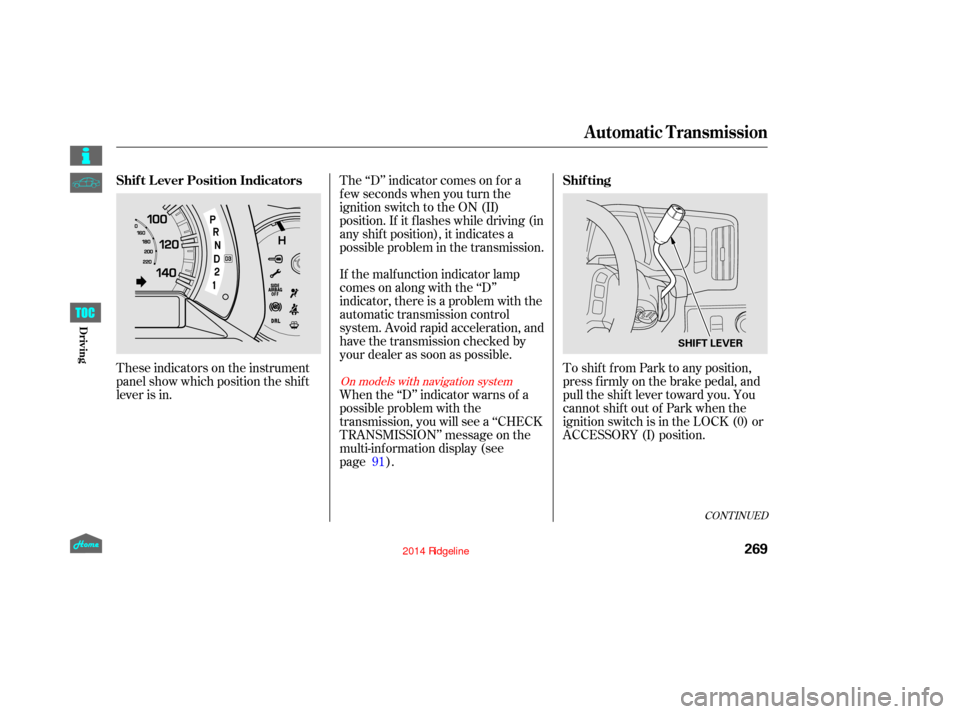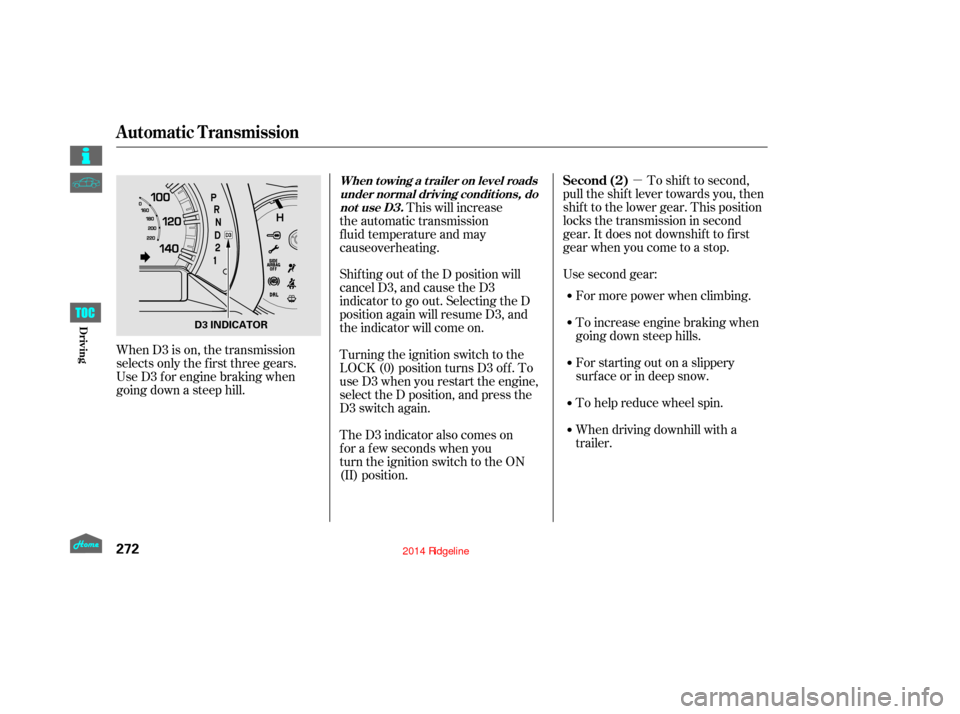Page 264 of 422

�µ�·
The resulting figure equals the
available amount of cargo and
luggage load capacity. For
example, if the ‘‘XXX’’ amount
equals 1,400 lbs. and there will be
five 150 lb. passengers in your
vehicle, the amount of available
cargo and luggage load capacity
is 650 lbs.
(1,400 750 (5 150) = 650 lbs.)
Determine the combined weight
of luggage and cargo being loaded
on the vehicle. That weight may
not saf ely exceed the available
cargo and luggage load capacity
calculated in Step 4.
If your vehicle will be towing a
trailer, load f rom your trailer will
be transf erred to your vehicle.
Consult this manual to determine
how this reduces the available
cargo and luggage load capacity of
your vehicle.
In addition, the total weight of the
vehicle, all occupants, accessories,
cargo, and trailer tongue load
must not exceed the Gross Vehicle
Weight Rating (GVWR) or the
Gross Axle Weight Rating
(GAWR). Both are on a label on
the driver’s doorjamb.
5.
6. 4.
Example 3 Example 2
Example 1
Carrying Cargo
259
Passenger Weight
(150 lbs x 2 = 300 lbs)
(68kgx2=136kg)Cargo Weight
(1,220 lbs)
(554 kg)
Max Load (1,520 lbs)
(690 kg)
Max Load (1,520 lbs) (690 kg)
Max Load (1,520 lbs) (690 kg) Passenger Weight
(150 lbs x 4 = 600 lbs)
(68kgx4=272kg)
Passenger Weight
(150 lbs x 5 = 750 lbs)
(68kgx5=340kg)
Cargo Weight
(770 lbs)
(350 kg) Cargo Weight
(920 lbs)
(418 kg)
12/08/09 16:33:43 31SJC670_266
Bef ore Driving
Page 270 of 422

This section gives you tips on
starting the engine under various
conditions, and how to operate the
automatic transmission. It also
includes important inf ormation on
parking your vehicle, the braking
system, the Variable Torque
Management
4-wheel drive
(VTM-4
) system, the vehicle
stability assist (VSA
), aka
Electronic Stability Control (ESC),
system, the tire pressure monitoring
system (TPMS), and f acts you need
if you are planning to tow a trailer or
drive of f -highway. ........................
Driving Guidelines .266
........................
Preparing to Drive .267
.......................
Starting the Engine .268
..............
Automatic Transmission . 269
Variable Torque Management
...........
4WD (VTM-4) System . 274
Tire Pressure Monitoring System ......................................
(TPMS) .276
...........................................
Parking .284
.............................
Braking System .286
...............
Anti-lock Brakes (ABS) . 287
Vehicle Stability Assist (VSA
),
aka Electronic Stability Control .......................
(ESC), System .288
.................
Towing Weight Limits . 291
..........
Towing Weight Guidelines . 293
...........................
Towing a Trailer .294
Of f -Highway Driving ..................................
Guidelines .304
Driving
265
12/08/09 16:34:17 31SJC670_272
Page 274 of 422

These indicators on the instrument
panel show which position the shif t
lever is in.The ‘‘D’’ indicator comes on f or a
f ew seconds when you turn the
ignition switch to the ON (II)
position. If it f lashes while driving (in
any shif t position), it indicates a
possible problem in the transmission.
If the malf unction indicator lamp
comes on along with the ‘‘D’’
indicator, there is a problem with the
automatic transmission control
system. Avoid rapid acceleration, and
have the transmission checked by
your dealer as soon as possible.
To shif t f rom Park to any position,
pressfirmlyonthebrakepedal,and
pull the shif t lever toward you. You
cannot shif t out of Park when the
ignition switch is in the LOCK (0) or
ACCESSORY (I) position.
When the ‘‘D’’ indicator warns of a
possible problem with the
transmission, you will see a ‘‘CHECK
TRANSMISSION’’ message on the
multi-information display (see
page
).
91
CONT INUED
On models with navigation system
Shif t L ever Position Indicators Shif ting
Automatic Transmission
269
SHIFT LEVER
12/08/09 16:34:49 31SJC670_276
Driving
Page 275 of 422

�µ�µThis position mechani-
cally locks the transmission. Use
Park whenever you are turning of f or
starting the engine. To shif t out of
Park, you must press on the brake
pedal and have your f oot of f the
accelerator pedal. Pull the shift lever
towards you, then move it out
If you have done all of the above and
still cannot move the lever out of
Park, see on
page .
You must also pull the shif t lever
towards you to shift into Park. To
avoid transmission damage, come to
a complete stop bef ore shif ting into
Park. The shif t lever must be in Park
for you to remove the key from the
ignition switch. Press the brake
pedal and pull the shift lever towards
you to shift from Park to reverse. To
shift from reverse to neutral, come
to a complete stop, and then shift.
Pull the shift lever towards you
before shifting into reverse
273
To shift from: PtoR
RtoP
NtoR Dto2 2to1
1to2
2toD
DtoN
NtoD RtoN Do this:
Press the brake pedal, and
pull the shift lever towards
you.
Pull the shift lever towards
you.
Move the shift lever.
Automatic Transmission
Park (P)
Shif t L ock Release Reverse (R)
270
12/08/09 16:34:54 31SJC670_277
Driving
of Park.
from neutral.
Page 277 of 422

�µTo shif t to second,
pull the shif t lever towards you, then
shif t to the lower gear. This position
locks the transmission in second
gear. It does not downshif t to f irst
gear when you come to a stop.
Use second gear:
For more power when climbing.
To increase engine braking when
going down steep hills.
For starting out on a slippery
surf ace or in deep snow.
To help reduce wheel spin.
When driving downhill with a
trailer.
This will increase
Shif ting out of the D position will
cancel D3, and cause the D3
indicator to go out. Selecting the D
position again will resume D3, and
the indicator will come on.
Turning the ignition switch to the
LOCK (0) position turns D3 of f . To
use D3 when you restart the engine,
select the D position, and press the
D3 switch again.
The D3 indicator also comes on
for a few seconds when you
turn the ignition switch to the ON
(II) position.
When D3 is on, the transmission
selects only the f irst three gears.
Use D3 f or engine braking when
going down a steep hill.
Automatic Transmission
Second (2)When t owing a t railer on level roads
under normal driving condit ions, donot use D3.
272
D3 INDICATOR
12/08/09 16:35:09 31SJC670_279
Driving
the automatic transmission
fluid temperature and may
cause overheating.
Page 278 of 422

�µTo shif t f rom second to
first, pull the shift lever towards you,
then shif t to the lower gear. This
position locks the transmission in
f irst gear. By upshif ting and
downshif ting through 1, 2, and D,
you can operate the transmission
much like a manual transmission
without a clutch pedal.
If you shif t into f irst position when
the vehicle speed is above 28 mph
(45 km/h), the transmission shif ts
into second gear first to avoid
sudden engine braking. If you exceed the maximum speed
f or the gear you are in, the engine
speed will enter into the tachometer’s
red zone. If this occurs, you may f eel
the engine cut in and out. This is
caused by a limiter in the engine’s
computer controls. The engine will
run normally when you reduce the
rpm below the red zone.
This allows you to move the shif t
lever out of Park if the normal
method of pushing on the brake
pedal and pulling the shif t lever does
not work.
Set the parking brake.
Make sure the ignition switch is in
the LOCK (0) position.
Putaclothonthenotchof the
shif t lock release slot cover to
prevent scratches. Using a small
f lat-tip screwdriver or a metal
f ingernail f ile, caref ully pry on the
notch of the cover to remove it.
1.
2.
3.
CONT INUED
First (1)
Engine Speed Limiter Shift Lock Release
Automatic Transmission
273
12/08/09 16:35:17 31SJC670_280
Driving
Page 279 of 422
Insert the built-in key into the shift
lock release slot.
Push down on the key while you
pull the shif t lever towards you,
and move it out of Park to neutral.Remove the key from the shift
lock release slot, then reinstall the
cover. Make sure the notch on the
cover is on the instrument panel
side. Insert the key into the
ignition switch, press the brake
pedal, and restart the engine.Your vehicle is equipped with a
Variable Torque Management
4-wheel-drive system (VTM-4)that
distributes engine torque to the
appropriate drive axle depending on
the available traction conditions. The
system is completely automatic,
always active, and does not require
any driver interaction.
If you need to use the shif t lock
release, it means your vehicle is
developing a problem. Have it
checked by your dealer. 6.
4.
5.
Automatic Transmission, VTM-4System
VTM-4System
274
SHIFT LOCK RELEASE SLOT
COVER
VTM-4 LOCK BUTTON
12/08/09 16:35:25 31SJC670_281
Driving
Page 290 of 422
Make sure the parking brake is
f ully released bef ore driving away.
Driving with the parking brake
partially set can overheat or
damage the rear brakes.
Make sure the moonroof (if
equipped) and the
windows are closed.
Turn of f the lights.
Place any packages, valuables, etc.
in the cargo area in your vehicle or
the In-Bed Trunk, or take them
with you.
Lock the doors.
Check the indicator on the driver’s
door to verify that the security
system is set.
Never park over dry leaves, tall
grass, or other f lammable
materials. The hot three way
catalytic converter could cause
these materials to catch on fire.If the vehicle is facing uphill,
turn the front wheels away
from the curb.
If the vehicle is facing downhill,
turn the front wheels toward
the curb.
On vehicles with security system
Parking
Parking T ips
285
12/08/09 16:36:43 31SJC670_292
Driving